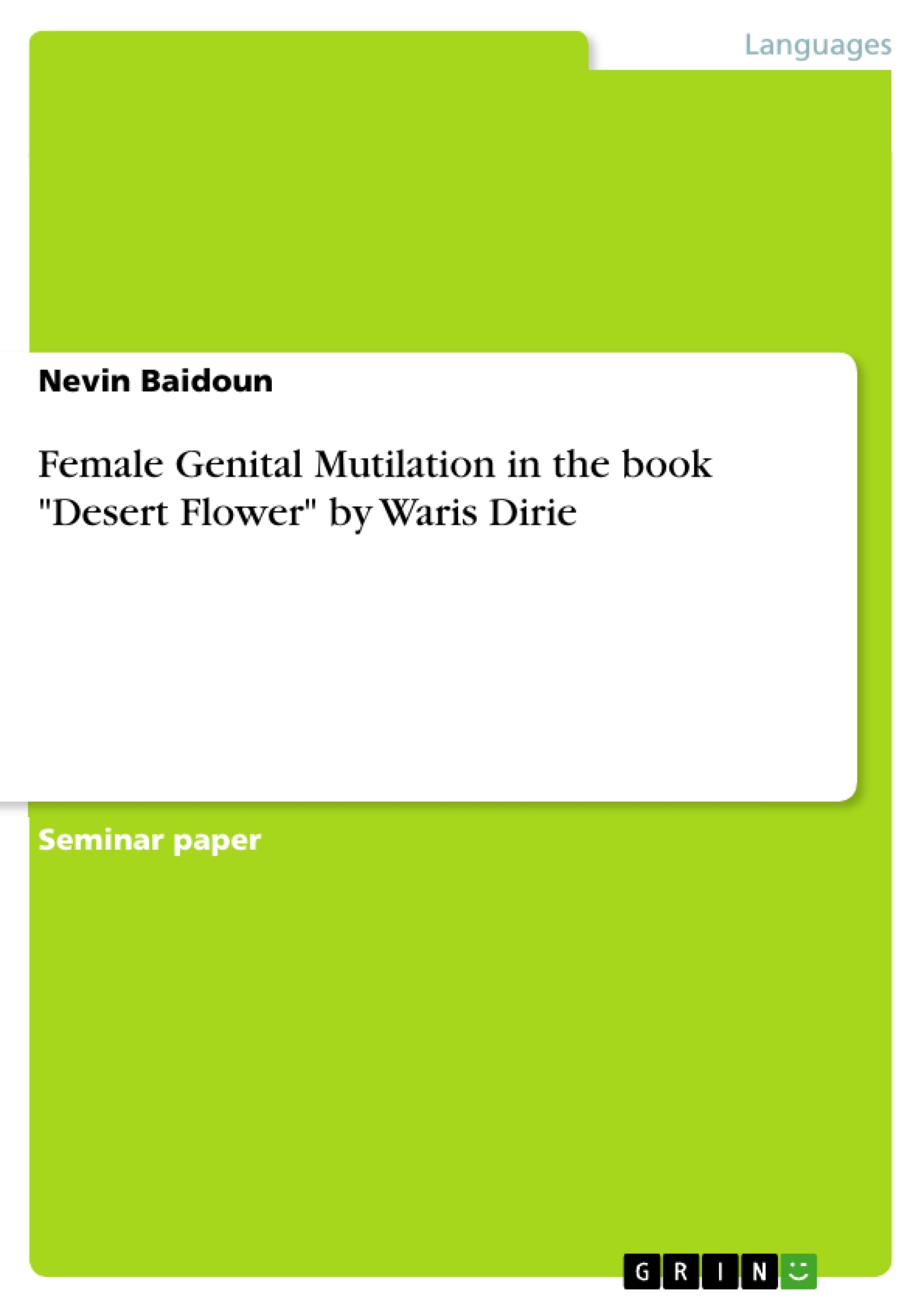The paper deals with the topic of female genital mutilation in the book “Desert Flower” by Waris Dirie. Waris Dirie became a bestselling author through her autobiographical novel in which she describes, inter alia, her childhood in Somalia and thus the genital mutilation she and her sister had to undergo. It is a lifestory which has contributed a significant part to the worldwide combating of FGM through the establishment of the Desert Flower Foundation.
Simultaneously, Waris’ success story is a political tool for the world’s fight against genital mutilation and for human rights. The principal tool therefore is a natural non-dramatic perspective exposing her intimate experience, which is, in this case, her and her sister’s genital mutilation in their childhood.
Table of Contents
- 1 Introduction
- 2 An overview of Desert Flower – The Extraordinary Life of a Desert Nomad by Waris Dirie and Cathleen Miller
- 3 What is Female Genital Mutilation?
- 4 Analysis of the chapter becoming a woman
- 5 Conclusion
Objectives and Key Themes
The main objective of this paper is to analyze Waris Dirie's autobiography, Desert Flower, focusing on its depiction of female genital mutilation (FGM). The paper examines the cultural context of FGM, its consequences, and Dirie's personal experience as a means of understanding the global fight against this human rights violation.
- The cultural context and practices surrounding FGM in Somalia.
- The physical and psychological consequences of FGM on individual women.
- Waris Dirie's personal narrative and her journey from victim to activist.
- The role of autobiography in raising awareness about FGM.
- The broader implications of FGM for women's rights and global health.
Chapter Summaries
1 Introduction: This introductory chapter sets the stage by highlighting the alarming prevalence of female genital mutilation (FGM) worldwide, citing statistics from organizations like the Desert Flower Foundation and UNICEF. It underscores the human rights violations inherent in FGM and notes the progress made in combating it over the past 25 years. The chapter introduces Waris Dirie as a prominent example of a woman who has bravely spoken out against FGM and uses her autobiographical work, Desert Flower, as a case study for understanding the issue's impact. The introduction emphasizes the significance of Dirie's story in the global fight against FGM and frames her experiences as a powerful tool for advocacy and change.
2 An overview of Desert Flower – The Extraordinary Life of a Desert Nomad by Waris Dirie and Cathleen Miller: This chapter provides a synopsis of Waris Dirie's autobiography, highlighting its narrative structure and perspective. It details Dirie's life as a nomadic girl in Somalia, emphasizing both the happy aspects of her early childhood and the harsh realities she faced, including sexual abuse and the eventual FGM she experienced. The chapter focuses on Dirie's escape from her family and her subsequent journey to Mogadishu and then London, marking her transition from a nomadic girl to a successful international model and activist. The chapter emphasizes how her narrative combines personal experience with a larger social and political context, making it a powerful tool for activism.
3 What is Female Genital Mutilation?: This chapter offers a definition of female genital mutilation (FGM) according to the World Health Organization, clarifying the various procedures encompassed by the term. It outlines the geographic distribution of FGM, focusing on regions with high prevalence rates such as Somalia, Guinea, and Egypt, and describes the methods used and the devastating physical and psychological consequences resulting from the procedure. The chapter also discusses different terms used to describe FGM, highlighting the ongoing debate surrounding the most appropriate language. Finally, it examines the cultural significance attributed to FGM in some societies, explaining its connection to marriage and societal norms despite its lack of health benefits.
Keywords
Female Genital Mutilation (FGM), Waris Dirie, Desert Flower, autobiography, human rights, Somalia, cultural context, female circumcision, gender inequality, activism, global health.
Frequently Asked Questions: Desert Flower - The Extraordinary Life of a Desert Nomad
What is the main focus of this analysis?
This analysis focuses on Waris Dirie's autobiography, Desert Flower, examining its depiction of female genital mutilation (FGM), its cultural context, consequences, and Dirie's personal journey from victim to activist. The analysis also explores the role of autobiography in raising awareness about FGM.
What are the key themes explored in the analysis?
Key themes include the cultural context and practices surrounding FGM in Somalia, the physical and psychological consequences of FGM, Dirie's personal narrative and her transformation into an activist, the role of autobiography in raising awareness, and the broader implications of FGM for women's rights and global health.
What is covered in the "Chapter Summaries" section?
The chapter summaries provide overviews of each chapter of the analysis. The introduction establishes the prevalence of FGM, introduces Waris Dirie and her autobiography as a case study. The overview of Desert Flower summarizes Dirie's life, from her nomadic childhood to her success as a model and activist. The chapter on FGM provides a definition, geographic distribution, methods, consequences, and cultural significance.
What is the objective of this paper?
The main objective is to analyze Desert Flower, focusing on its depiction of FGM to understand the global fight against this human rights violation. It examines the cultural context, consequences, and Dirie's personal experience.
What are the key words associated with this analysis?
Key words include Female Genital Mutilation (FGM), Waris Dirie, Desert Flower, autobiography, human rights, Somalia, cultural context, female circumcision, gender inequality, activism, and global health.
What is included in the Table of Contents?
The table of contents includes: an introduction, an overview of Desert Flower, a section explaining what Female Genital Mutilation is, an analysis of a specific chapter (becoming a woman), and a conclusion.
- Quote paper
- Nevin Baidoun (Author), 2018, Female Genital Mutilation in the book "Desert Flower" by Waris Dirie, Munich, GRIN Verlag, https://www.grin.com/document/1042141




